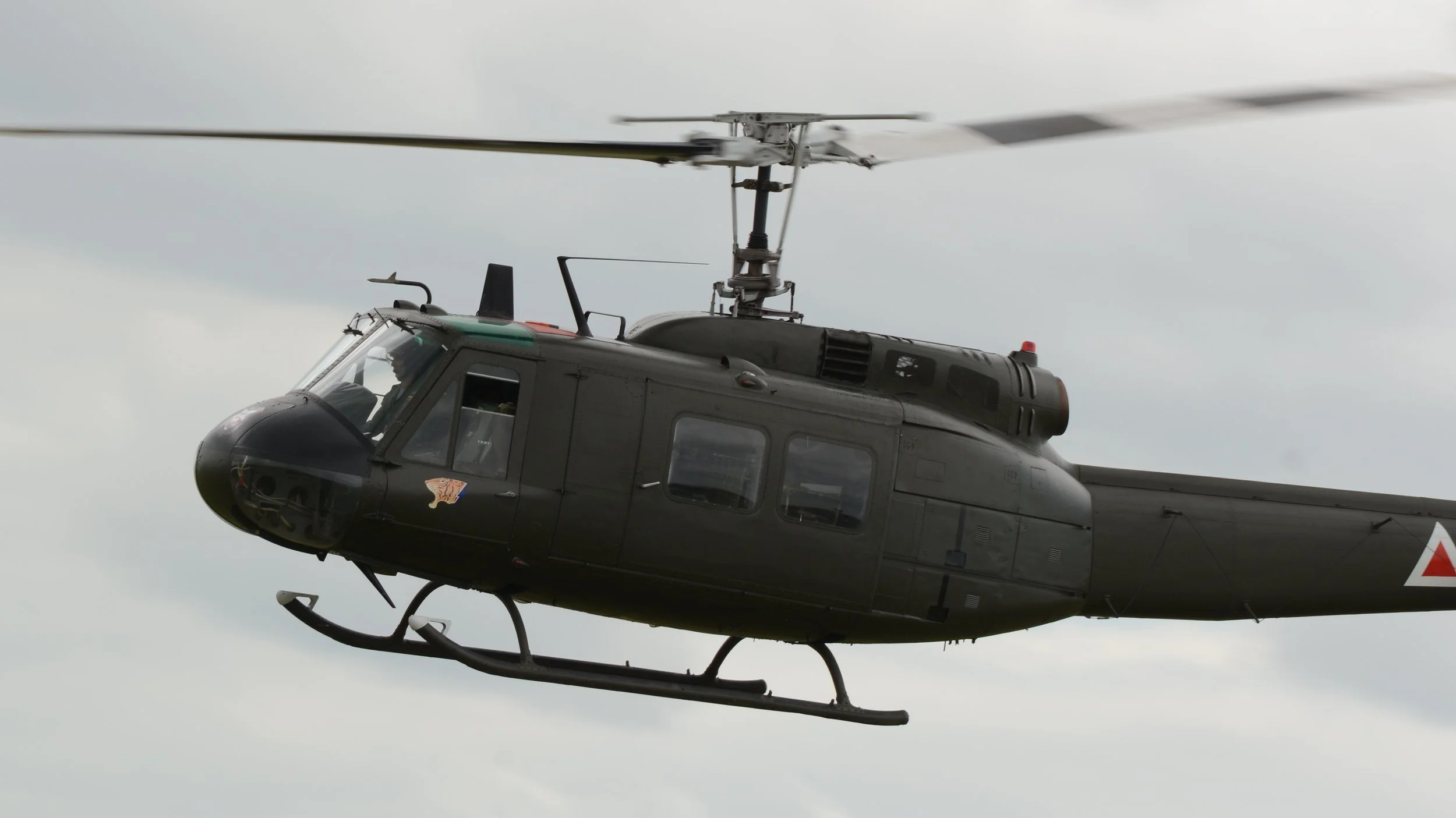
October 20 / Bell UH-1 Iroquois first flight
First Flight 20 October 1956
Bell UH-1 Iroquios
The Bell UH-1 Iroquois, affectionately nicknamed “Huey,” is a utility military helicopter designed and produced by the American aerospace company Bell Helicopter. It holds the distinction of being the first member of the prolific Huey family and the first turbine-powered helicopter to enter service with the United States military, marking a significant advancement in rotary-wing aviation.
The development of the Iroquois began in the early 1950s, driven by a United States Army requirement for a new medical evacuation and utility helicopter. Bell Helicopter responded with the Bell 204, which first took to the skies on October 20, 1956. The prototype was warmly received, particularly for its performance, which was superior to piston engine-powered helicopters of the time due to its single turboshaft engine. In March 1960, Bell received an initial production contract for 100 HU-1A helicopters. The designation “HU-1” led to the affectionate nickname “Huey,” which has persisted even after the official redesignation to UH-1 in 1962.
The early models were powered by the Lycoming YT53-L-1 engine, producing 700 shp (520 kW). However, in response to feedback regarding the helicopter’s power, Bell quickly developed more powerful variants. By 1966, some models were equipped with the Lycoming T53-L-13 engine, capable of producing 1,400 shp (1,000 kW). To meet the Army’s demand for a helicopter that could carry more troops, a stretched version of the Iroquois was developed and first flown in August 1961. Other modifications included the adoption of all-aluminum construction, the addition of a rotor brake, and the use of alternative powerplants. These changes improved the helicopter’s versatility and performance, making it suitable for a wide range of military operations.
The Iroquois was first deployed in combat during the Vietnam War, with the initial units arriving in March 1962. Its versatility made it invaluable for various missions, including general support, air assault, cargo transport, aeromedical evacuation, search and rescue, electronic warfare, and ground attack. Armed versions, known as gunships, were equipped with rockets, grenade launchers, and machine guns and were often field-modified to meet specific operational needs. The United States Air Force also utilized the Iroquois in Vietnam for reconnaissance, psychological warfare, and other support roles. The Royal Australian Air Force and other allied nations also deployed their Iroquois helicopters to Vietnam. In total, around 7,000 Iroquois helicopters were deployed in the Vietnam theater, with over 3,300 being destroyed during the conflict.
Beyond Vietnam, the Iroquois saw action in various other conflicts, including the Rhodesian Bush War, the Falklands War, the War in Afghanistan, and the 2007 Lebanon conflict. Its robust design and adaptability ensured its continued use in diverse combat environments worldwide.
The Iroquois family expanded with numerous derivatives and developments. The Bell AH-1 Cobra, a dedicated attack helicopter, was derived from the UH-1 and shared many components. The Bell 204 and 205 were civilian versions of the Iroquois. In response to customer demands, Bell developed the twin-engined UH-1N Twin Huey in the late 1960s and the four-bladed UH-1Y Venom in the early 21st century.
In the U.S. Army, the Iroquois was gradually phased out with the introduction of more advanced helicopters like the Sikorsky UH-60 Black Hawk and the Eurocopter UH-72 Lakota. Despite this, hundreds of Hueys remained in service more than 50 years after their introduction, a testament to their enduring utility and reliability.
Since 1960, over 16,000 Iroquois helicopters have been built, making it one of the most prolific and influential helicopters in history. The Huey’s impact on military aviation and its iconic status, particularly from its extensive use during the Vietnam War, have cemented its place in both military and aviation history.
Huey Facts
First Turbine-Powered Helicopter: The Bell UH-1 Iroquois, nicknamed “Huey,” was the first turbine-powered helicopter to enter service with the United States military.
Initial Flight: The prototype, known as the Bell 204, first flew on October 20, 1956, and was well-received for its performance over piston engine-powered counterparts.
Nickname Origin: The original designation of the helicopter was HU-1, which led to the nickname “Huey.” This nickname persisted even after the official redesignation to UH-1 in 1962.
Vietnam War Service: The Iroquois was first deployed in combat during the Vietnam War in March 1962. It was used for various missions, including general support, air assault, cargo transport, aeromedical evacuation, search and rescue, electronic warfare, and ground attack.
Weaponry: Armed Iroquois gunships were equipped with a variety of weapons, including rockets, grenade launchers, and machine guns. These gunships were often modified in the field to meet specific operational needs.
Global Deployment: In addition to the Vietnam War, the Iroquois saw action in several other conflicts, such as the Rhodesian Bush War, the Falklands War, the War in Afghanistan, and the 2007 Lebanon conflict.
Production Numbers: Since its introduction, over 16,000 Iroquois helicopters have been built, making it one of the most prolific helicopters in history.
Derivatives: The UH-1 family includes numerous derivatives, such as the Bell AH-1 Cobra, a dedicated attack helicopter, and the civilian Bell 204 and 205 models. The UH-1N Twin Huey and the four-bladed UH-1Y Venom are other notable variants.
Engine Evolution: The initial models were powered by the Lycoming YT53-L-1 engine, producing 700 shp (520 kW). By 1966, more powerful models were equipped with the Lycoming T53-L-13 engine, capable of 1,400 shp (1,000 kW).
Continued Use: Despite being gradually phased out in favor of more advanced helicopters like the Sikorsky UH-60 Black Hawk and the Eurocopter UH-72 Lakota, hundreds of Hueys remained in service more than 50 years after their introduction, underscoring their enduring utility and reliability.







